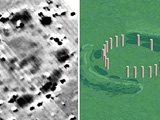|
|
TODAY.AZ / Weird / Interesting
Archaeologists found "the most important discovery at the world famous site for 50 years"
23 July 2010 [10:25] - TODAY.AZ
Archaeologists have found Stonehenge's lost "twin" - described as the most important discovery at the world famous site for 50 years.
 The second henge, which is thought to be a ceremonial monument, is about 900m from the ancient stones on Salisbury Plain in Wiltshire. From above the discovery looks like any green field, but using ground-penetrating radar, experts say below the turf lies a circular ditch containing 22 holes from wooden posts that have long rotted away.
The second henge, which is thought to be a ceremonial monument, is about 900m from the ancient stones on Salisbury Plain in Wiltshire. From above the discovery looks like any green field, but using ground-penetrating radar, experts say below the turf lies a circular ditch containing 22 holes from wooden posts that have long rotted away.Inside the circle are the remains of a burial barrow, which appeared much later and may have been excavated in the early 1900s. The 'wooden Stonehenge' was uncovered just two weeks into a three-year project, led by the University of Birmingham and the Ludwig Boltzmann Institute in Austria. Its aim is to map the area around the World Heritage Site for signs of villages or any other structures.
Professor Vince Gaffney, from the university, said: "It will completely change the way we think about the landscape around Stonehenge. "People have tended to think that as Stonehenge reached its peak, it was the paramount monument, existing in splendid isolation.
"This discovery is completely new and extremely important in how we understand Stonehenge and its landscape."
It appears to have been built on the same orientation as the world-renowned monument, and has entrances to the north east and south west. Prof Gaffney added: "To put this in context, we haven't found a major ceremonial site of this type, or of this significance, for probably 50 years or more within the area of Stonehenge.
"The presumption was this was just an empty field - now we have got a major ceremonial monument, looking at Stonehenge."
English Heritage archaeologist Amanda Chadburn said it was part of a growing body of evidence which showed how important summer and winter solstices were to the people who built Stonehenge some 4,500 years ago.
"The discovery is all the more remarkable, given how much research there has been in the vicinity of Stonehenge," she added.
/Sky News/
URL: http://www.today.az/news/interesting/71303.html
 Print version
Print version
Views: 3019
Connect with us. Get latest news and updates.
See Also
- 19 February 2025 [22:20]
Visa and Mastercard can return to Russia, but with restrictions - 05 February 2025 [19:41]
Japan plans to negotiate with Trump to increase LNG imports from United States - 23 January 2025 [23:20]
Dubai once again named cleanest city in the world - 06 December 2024 [22:20]
Are scented candles harmful to health? - 23 November 2024 [14:11]
Magnitude 4.5 earthquake hits Azerbaijan's Lachin - 20 November 2024 [23:30]
Launch vehicle with prototype of Starship made its sixth test flight - 27 October 2024 [09:00]
Fuel prices expected to rise in Sweden - 24 October 2024 [19:14]
Turkiye strikes terror targets in Iraq and Syria - 23 October 2024 [23:46]
Kazakhstan supplied almost entire volume of oil planned for 2024 to Germany in 9 months - 23 October 2024 [22:17]
Taiwan reported passage of Chinese Navy aircraft carrier near island
Most Popular
 Antalya Diplomacy Forum becomes center of global dialogue
Antalya Diplomacy Forum becomes center of global dialogue
 Separatists & Pashinyan - the farce continues
Separatists & Pashinyan - the farce continues
 The "parallel" worlds of Armenia
The "parallel" worlds of Armenia
 4SIM signs MoUs with Chinese institutions to boost cooperation in green and industrial technologies
4SIM signs MoUs with Chinese institutions to boost cooperation in green and industrial technologies
 Azerbaijani and Georgian Presidents hold expanded meeting over luncheon
Azerbaijani and Georgian Presidents hold expanded meeting over luncheon
 A fat, nosy and bald hint that Armenia will remove claims against Azerbaijan from the Constitution
A fat, nosy and bald hint that Armenia will remove claims against Azerbaijan from the Constitution
 Foreign diplomats tour liberated cities of Khankendi and Shusha
Foreign diplomats tour liberated cities of Khankendi and Shusha
